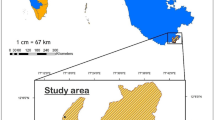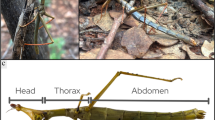Abstract
The effectiveness of predator fecal odors in modifying feeding selection by sheep and cattle was investigated in two trials. In trial 1, animals could select from feed bins contaminated with coyote, fox, cougar, or bear fecal odor, and oil of wintergreen, or select the control feed. All odors were rejected (P<0.01) by sheep and cattle, except bear odors by sheep. In trial 2, animals could select feed during 10-min periods in an open 11-m × 16-m arena. Fecal odor did not influence approaches to feed bins, or head entries into bins. Only coyote fecal odor reduced (P<0.05) the time spent feeding in the contaminated bin, and increased (P<0.05) consumption from the control bin by both cattle and sheep. Some animals on some test days refused to feed from either feed bin, although cattle and sheep closely inspected bins. Results suggest that fecal odors may not prevent livestock from entering a treated area but may reduce the time spent grazing in such an area.
Similar content being viewed by others
References
Abbott, D.H., Baines, D.A., Faulkes, C.G., Lewis, E., Ning, P.C.Y.K., andTomlinson, A.J. 1989. A natural deer repellent: Chemistry and behaviour,in D. MacDonald and D. Muller-Schwarze (eds.). Chemical Signals in Vertebrates V. Oxford University Press, Cambridge, U.K. In press.
Arnold, G.W. 1966. The special senses in grazing animals. II. Smell, taste, and touch and dietary habits in sheep.Aust. J. Agric. Res. 17:531–542.
Arnold, G.W., andHill, J.L. 1972. Chemical factors affecting selection of food plants by ruminants, pp. 71–101,in J.B. Harborne (ed.). Phytochemical Ecology. Academic Press, London.
Arnold, G.W., de Boer, E.S., andBoundy, C.A.P. 1980. The influence of odour and taste on the food preferences and food intake of sheep.Aust. J. Agric. Res. 31:571–587.
Campbell, D.L., andBullard, R.W. 1972. A preference testing system for evaluating repellents for white-tailed deer.Vertebr. Pest Conf. 5:56–63.
Chapple, R.S., andLynch, J.J. 1986. Behavioral factors modifying acceptance of supplementary foods by sheep.Res. Dev. Agric. 3:113–120.
Conover, M.R. 1987. Comparison of two repellents for reducing deer damage to Japanese yews during winter.Wildl. Soc. Bull. 15:265–268.
Elliott, S., andLoudon, A. 1987. Effects of monoterpene odors on food selection by red deer calves (Cervus elaphus).J. Chem. Ecol. 13:1343–1349.
Engle, D.M., andSchimmel, J.G. 1984. Repellent effects on distribution of steers on native range.J. Range Manage. 37:140–141.
Gill, J.L. 1978. Design and Analysis of Experiments in the Animal and Medical Sciences, Vol. 2, The Iowa State University Press, Ames.
Hutson, G.D. 1982. ‘Flight distance’ in Merino sheep.Anim. Prod. 35:231–235.
Knowles, R.I., andTahan, F. 1979. A repellent to protect radiata pine seedlings from browsing by sheep.N.Z. J. For. Sci. 9:3–9.
Melchiors, M.A., andLeslie, C.A. 1984. Effectiveness of predator fecal odors as black-tailed deer repellents.J. Wildl. Manage. 49:358–362.
Müller-Schwarze, D. 1972. Responses of young black-tailed deer to predator odors.J. Mammal. 53:393–394.
Müller-Schwarze, D. 1983. Experimental modulation of behavior of free-ranging mammals by semiochemicals, pp. 235–244,in D. Müller-Schwarze and R.M. Silverstein (eds.). Chemical Signals in Vertebrates III. Plenum Press, New York.
Pfister, J.A., Ralphs, M.H., andManners, G.D. 1988a. Cattle grazing tall larkspur on Utah mountain rangeland.J. Range Manage. 41:118–121.
Pfister, J.A., Manners, G.D., Ralphs, M.H., Hong, Z.X., andLane, M.A. 1988b. Effects of phenology, site and rumen fill on larkspur consumption by grazing cattle.J. Range Manage. 41:511–516.
Poindron, P. 1974. Methode de suppression reversible de l'odorat chez la brebis et verification de l'anosmie au moyen d'une epreuve comportementale.Ann. Biol. Anim. Biochim. Biophys. 14:411–415.
Ralphs, M.H., Olsen, J.D., Pfister, J.A., andManners, G.D. 1988. Plant-animal interactions in larkspur poisoning in cattle.J. Anim. Sci. 66:2334–2342.
Sullivan, T.P., Nordstrom, L.O., andSullivan, D.S. 1985a. Use of predator odors as repellents to reduce feeding damage by herbivores. II. Black-tailed deer (Odocoileus hemionus columbianus).J. Chem. Ecol. 11:921–935.
Sullivan, T.P., Nordstrom, L.O., andSullivan, D.S. 1985b. Use of predator odors as repellents to reduce feeding damage by herbivores. I. Snowshoe hares (Lepus americanus).J. Chem. Ecol. 11:903–920.
Sullivan, T.P., Crump, D.R., andSullivan, D.S. 1988a. Use of predator odors as repellents to reduce feeding damage by herbivores. III. Montane and Meadow Voles (Microtus montanus andMicrotus pennsylvanicus).J. Chem. Ecol. 14:363–377.
Sullivan, T.P., Crump, D.R., andSullivan, D.S. 1988b. Use of predator odors as repellents to reduce feeding damage by herbivores. IV. Northern Pocket Gophers (Thomomys talpoides).J. Chem. Ecol. 14:379–389.
Taylor, R.G., Workman, J.P., andBowns, J.E. 1979. The economics of sheep predation in southwestern Utah.J. Range Manage. 32:317–321.
Ydenberg, R.C., andDill, L.M. 1986. The economics of fleeing from predators.Adv. Study Behav. 16:229–249.
Author information
Authors and Affiliations
Additional information
This research was supported in part by the Utah Agric. Exper. Sta., Utah State University, Logan, Utah 84322. Approved as journal article no. 3721
Rights and permissions
About this article
Cite this article
Pfister, J.A., Müller-Schwarze, D. & Balph, D.F. Effects of predator fecal odors on feed selection by sheep and cattle. J Chem Ecol 16, 573–583 (1990). https://doi.org/10.1007/BF01021787
Received:
Accepted:
Issue Date:
DOI: https://doi.org/10.1007/BF01021787




